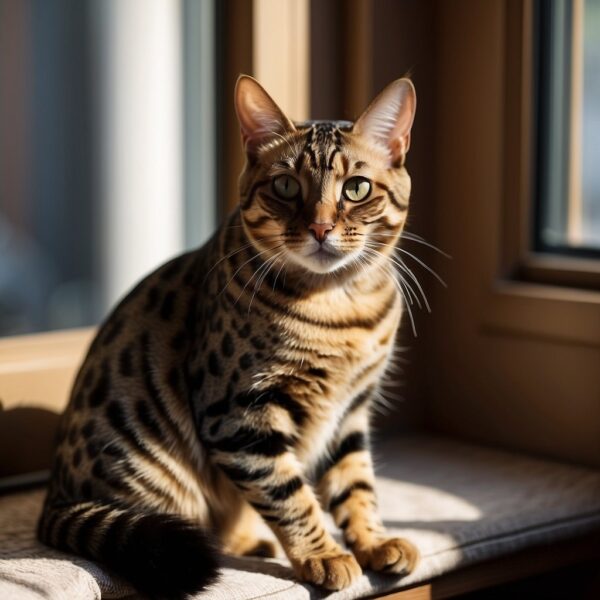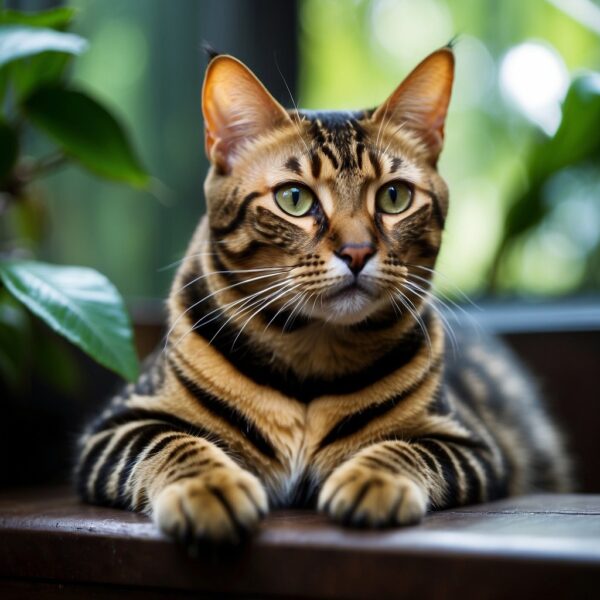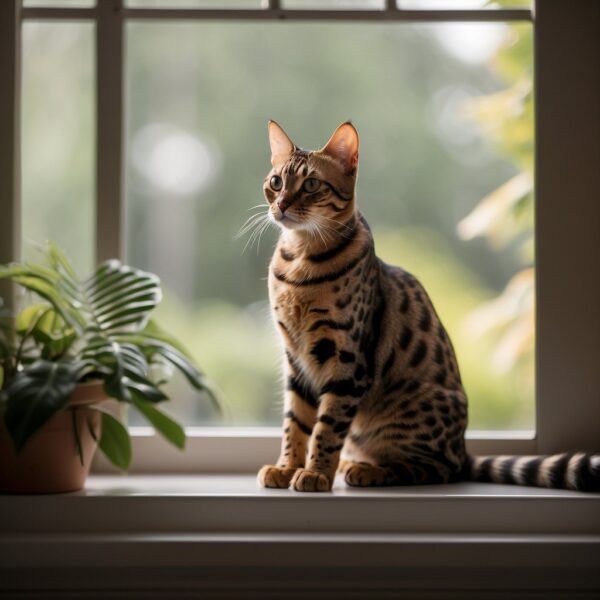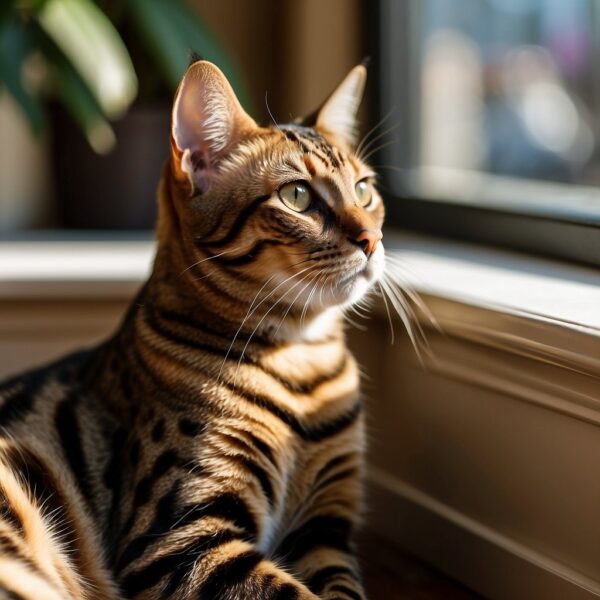
Bengal Cats: Are Hybrids good House Cats?
Bengal cats, acclaimed for their striking wild appearance reminiscent of a leopard, are a breed that sets the bar high for what it means to be a visually captivating house pet. With their distinctive coat patterns featuring spots, marbling, and a spectrum of colors, these felines have swiftly become an adored breed among cat enthusiasts. Originating from the crossbreeding of domestic cats with the Asian leopard cat, their history is as unique as their looks, offering an exotic allure paired with the temperament suited for a family environment.
Yet attractiveness is not the sole characteristic to consider when gauging the suitability of Bengal cats as household companions. Their behavior and temperament, often described as energetic and affectionate, demand careful consideration by potential owners. These intelligent cats typically form strong bonds with their human counterparts and may require more attention and interactive play than some other breeds. While Bengal cats can make rewarding pets, their vivacious nature means they thrive best with owners who can dedicate time and energy into catering to their social and environmental needs. This article delves further into what makes Bengal cats both a stunning and substantial commitment as pets.
Key Takeaways
- Bengal cats are known for their distinctive and attractive coat patterns.
- They originate from crossbreeding domestic cats with Asian leopard cats.
- Their energetic temperament requires dedicated time and involvement from owners.

Origins and History
The Bengal cat is a distinct hybrid breed, developed from the crossing of a domestic cat with an Asian Leopard Cat (ALC), scientifically termed Prionailurus bengalensis. The primary objective behind creating this breed was to transfer the wild leopard cat’s striking coat pattern to a domesticated feline that would be suitable as a pet.
Historical Progression:
- 1960s: The first recorded breeding between an ALC and a domestic cat.
- 1980s: Bengals were recognized as a new breed, with breeders refining their appearance and temperament.
Genetic Lineage:
- Asian Leopard Cat: A small wild cat native to Asia, its characteristics are dominant in the early generations of Bengals.
- Domestic Cats: Various domestic breeds were used to establish Bengal’s size and demeanor.
The breed has evolved into one with a stable temperament, yet retaining some of the physical traits of its wild ancestor. Early generations of Bengals (F1 and F2) are closer to the ALC, often requiring specific care. As the generations progress (F3 and beyond), a Bengal becomes more similar in behavior to domestic cats while maintaining the ALC’s physical aesthetic.
Official Recognition:
- TICA: The International Cat Association recognized Bengals in 1983.
- FIFe: The Fédération Internationale Féline provided recognition in 1997.
Today, Bengals are a sought-after breed for cat enthusiasts and families alike. They strike an enchanting balance with exotic looks and friendly dispositions.

Physical Characteristics
Bengal cats boast an impressive aesthetic that reflects their wild ancestry, from the distinctive patterns on their coat to their robust build. Their appearance exudes athleticism and has evolved to support a healthy, active lifestyle.
Coat and Patterns
Bengal cats are celebrated for their luxurious coats that mirror the appearance of their wild relatives. Their fur exhibits two primary patterns: rosettes and marbling. Rosettes are shaped like those found on leopards, with a different color in the center than the edges, while marbling gives a more random, swirled pattern. The base coat colors can range from golden, rust, brown, and orange to sand and ivory.
- Rosettes: Typically two-toned spots, resembling large, clustered freckles.
- Marbling: Swirls of extended and randomly aligned patches.
Size and Weight
The Bengal breed is larger than the average domestic cat.
- Male Bengals typically weigh between 10 to 15 pounds.
- Female Bengals are usually lighter, weighing around 8 to 12 pounds.
Unique Features
Bengal cats possess a distinctive set of features that set them apart from other domestic cats. Their eyes are piercing and can come in shades of blue, green, or gold. They often have a wild, athletic build, making them skilled climbers and jumpers. Health-wise, Bengals are generally healthy but can be predisposed to certain genetic conditions like hypertrophic cardiomyopathy.
Health and Lifespan
- Health: Bengals are hearty cats but may be susceptible to health issues such as hypertrophic cardiomyopathy, which is a heart condition that can be common in the breed.
- Lifespan: With proper care, Bengal cats typically enjoy a lifespan of 12 to 16 years. It’s essential for potential owners to be aware of their health needs and ensure they receive regular veterinary check-ups.

Bengal Cat Behavior and Temperament
The hybrid cats are known for their distinctive personality traits and high activity levels. Understanding their behavioral patterns and needs can guide pet owners to ensure a harmonious living environment.
Personality Traits
Bengal cats display a unique combination of intelligence, inquisitiveness, and playfulness. They are known to be highly affectionate and friendly, making strong bonds with their human companions. Their curiosity drives them to explore their surroundings thoroughly.
Activity Levels
Bengal cats have a high energy level that requires regular exercise and play. They are energetic and often engage in activities that stimulate them mentally and physically. Without appropriate mental stimulation, they may exhibit signs of boredom.
Social Interaction
These cats are known for their strong companionship qualities, often seeking active interaction with their owners. They are typically affectionate and can quickly become integral members of the family, enjoying the company of children and other pets if properly introduced.
Territorial and Environmental Needs
Bengal cats have pronounced territorial behaviors and require an environment with enough room to climb and explore. Adequate space is essential to mitigate any undesirable marking habits. Creating vertical spaces can satisfy their instinct to survey their territory from a high vantage point.

Bengal Cat Care and Management
Proper care and management are crucial for maintaining a healthy and happy Bengal cat. This includes detailed attention to their diet, grooming, exercise, and health needs.
Nutrition and Diet
Bengal cats require a balanced diet rich in protein to support their energetic lifestyle. They often do well on high-quality commercial cat food, but it’s important to ensure it is formulated to meet their nutritional needs. Occasional treats can be given, but they should be healthy options and constitute no more than 10% of the cat’s daily caloric intake.
- Protein Source: Preferably lean meats like chicken or turkey.
- Wet vs. Dry Food: A mixture is advisable for hydration and dental health.
- Frequency: Adult Bengals usually eat twice a day.
Grooming Requirements
Bengal cats boast a short, luxurious coat that requires minimal grooming. Regular brushing, around once a week, helps reduce shedding and prevent hairballs.
- Brush: Use a soft bristle or rubber brush.
- Bathing: Occasional bathing can keep their coat shiny, although often not necessary.
Exercise and Play
These cats are highly active and benefit from daily play that stimulates both their body and mind. Providing various toys and a scratching post mirrors their natural behaviors like climbing and scratching, which is essential for intellectual engagement.
- Interactive Toys: Laser pointers, feather wands, and puzzles.
- Cat Trees: Offer vertical space for climbing.
- Games: Engage in play that mimics hunting, such as fetch.
Training and Tricks
Their intelligence makes Bengal cats good candidates for learning tricks and commands. Training should be part of their routine for mental stimulation.
- Teach Tricks: Sit, high-five, or come can be taught with patience.
- Walk: They can be harnessed and taken for walks outside for both exercise and environment exploration.
Health Monitoring
Regular check-ups with a veterinarian are vital to detect any health issues early. Bengal cats can be prone to certain hereditary conditions, so maintaining an oversight on their health is key.
- Veterinarian Visits: At least once a year for a health check-up.
- Watch For: Signs of discomfort or changes in behavior which may indicate health problems.
Adoption and Ownership
Adopting a Bengal cat is a significant decision that hinges on understanding the breed’s specific characteristics. Prospective owners should evaluate whether their personality and lifestyle align with the needs of these energetic and engaging companions.
Choosing a Bengal Cat
When considering adoption, it’s crucial to recognize that Bengal cats are known for their distinctive coat that mimics wild cats, such as leopards. They are not just a visually striking breed; they also boast a playful and engaging personality. When choosing a Bengal cat, prospective owners should connect with reputable breeders or rescue organizations to ensure the cat’s health and well-being. Some key aspects include:
- Health clearances: Verify the cat’s health history and vaccinations.
- Temperament: Spend time with the cat to understand its personality.
- Lineage: Inquire about the cat’s lineage to ensure it’s a good fit for your family.
Pros and Cons of Bengal Ownership
Bengal cats offer a unique ownership experience. Below is a table highlighting the pros and cons:
| Pros | Cons |
|---|---|
| Highly social and friendly with humans and other pets | May require more attention and engagement |
| Tend to be vocal and interactive | Their playful nature can lead to mischief without adequate stimulation |
| Innovative breed with beautiful spotted or marbled coats | Potential for genetic health issues; important to screen for these during adoption |
Integrating into the Household
Integrating a Bengal cat into a household with existing pets, such as other domestic cats or dogs, should be a gradual process. An introduction phase is key, where the new Bengal is kept separate at first, allowing other animals to become accustomed to its scent. A stepwise approach to introduction will ensure a smoother transition:
- Keep the Bengal in its own space initially with its own food, water, and litter box.
- Gradually introduce the Bengal to the other family members, including both humans and animals.
- Supervise initial interactions to monitor the behavior and compatibility of the pets.
Remember that Bengal cats can be particularly affectionate and playful, and typically integrate well into active households.
Conclusion
Bengal cats are a distinctive breed known for their striking appearance and vibrant personalities. Several studies emphasize the importance of understanding the breed’s specific health and behavioral characteristics to ensure they thrive as pets.
Key considerations for Bengal cat owners include:
- Health: Research indicates Bengal cats may be predisposed to certain health conditions, such as hypertrophic cardiomyopathy, which necessitates regular veterinary check-ups to maintain their wellbeing.
- Environment: As highly active and intelligent felines, they require stimulating environments to prevent potential behavioral issues. Their need for engagement can be met with interactive toys and space to explore.
- Socialization: Bengals are generally sociable with their human companions and may get along well with other pets if properly introduced.
If these factors are met, Bengal cats can be affectionate, entertaining, and loyal companions. The choice to adopt a Bengal cat should come with a commitment to meet their unique needs, ensuring a harmonious relationship between the cat and their owner. Owners should be prepared for a long-term commitment, acknowledging the breed’s longevity and the importance of providing a loving home for the duration of their lives.
Frequently Asked Questions
This section addresses common inquiries potential and current Bengal cat guardians might have regarding the breed’s distinct characteristics and necessities.
What is the typical behavior and temperament of Bengal cats as house pets?
Bengal cats are known for their high energy and intelligence. They exhibit playful and adventurous behaviors and may require more interactive playtime than other cat breeds. Owners often find Bengal cats to be affectionate yet sometimes demanding.
How much does a Bengal cat typically cost to purchase and care for?
The initial cost to purchase a Bengal cat can range significantly, often from several hundred to a few thousand dollars, depending on pedigree and markings. The lifetime cost of care includes food, healthcare, and other essentials, averaging between $1,000 and $3,000 annually.
What legal considerations should one be aware of when owning a Bengal cat?
Legally, owning a Bengal cat may require specific checks, as some regions have laws regarding the ownership of hybrid breeds. Prospective owners should verify local legislation to ensure compliance.
How do Bengal cats fare with families and children?
Bengal cats are typically good with families and can coexist happily with children, especially when socialized from a young age. Their playful nature often makes them suitable companions for active households.
What is the average lifespan of a Bengal cat and how can it be optimized?
Bengal cats generally have a lifespan of 12 to 16 years. Their health and longevity can be optimized through regular veterinary care, proper nutrition, and an environment that stimulates their active nature.
Do Bengal cats require specialized care or attention compared to other cat breeds?
Bengal cats do not require specialized care but benefit from environments where they can fulfill their need for physical activity and mental stimulation. They thrive on interactive play and may require more attention to prevent boredom-related behaviors.